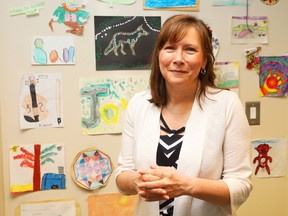The algorithm works by scanning the hospital’s electronic health records. It helps identify children and youth who have a higher chance of having a rare genetic disorder.

Article content
Georges Wistaff calls CHEO his family’s second home. They have made more than 100 trips there over the last decade, mostly because of health issues involving their 10-year-old son, Antony.
Antony was born prematurely and underwent emergency surgery soon after. That was the start of a medical odyssey for the Ottawa boy and his family that has meant multiple assessments and treatments for physical, neurological and developmental issues over the years.
Advertisement 2
Article content
Article content
Antony’s parents always wondered about the source of their son’s health issues. Earlier this year — with the help of artificial intelligence — they got an answer.
In a world-first, researchers at CHEO used artificial intelligence to develop an algorithm that identifies children and youth who might have an undiagnosed rare genetic disease.
For the Wistaff family, knowing that Antony was born with the extremely rare Chung-Jansen Syndrome brought clarity. He is one of only 400 people worldwide who have been diagnosed with the rare disorder caused by a change in the DNA sequence of a gene. The diagnosis helps explain some of his health challenges, ranging from hydrocephalus to developmental delays and learning difficulties.

“This research brought a kind of peace to our house,” said his father, Georges. “Had we known this sooner, it would have meant less questioning as parents, less stress and more support because we would have had a clear diagnosis for Antony. A little bit of blood and a simple test answered so many questions.”
That is a goal of the ThinkRare algorithm, said Dr. Kym Boycott, senior scientist at the CHEO Research Institute and chief of genetics at CHEO.
Advertisement 3
Article content
She called it a game-changer “because it means we can help families find answers and get the care and support they need sooner.”
Antony is one of three children and youth who have so far been identified by the algorithm and later confirmed through testing to have a rare genetic illness.
One of the others, a 17-year-old, was diagnosed with a rare disorder that puts him at elevated risk for certain cancers, something that calls for screening.
“We may have saved his life,” said Boycott.
The algorithm works by scanning the hospital’s electronic health records. It helps identify children and youth who have a higher chance of having a rare genetic disorder. They are often children and youth who been seen by numerous specialists and clinics for many different reasons but had never been suspected of having a rare genetic disorder.
The children and youth who are flagged by the algorithm are then given genetic testing to confirm whether they have a rare genetic disorder. So far, the first three children flagged by the algorithm were diagnosed with a rare disorder, and Boycott expects more.
Advertisement 4
Article content
Between one and three per cent of children have rare genetic disorders. Boycott said she expects the algorithm can help identify up to 50 children and youth every year who have fallen through the cracks and remain undiagnosed.
Although there are no treatments in many cases, there are management guidelines. Getting a diagnosis sooner can make a huge difference in a child’s life as well as their family’s, she said.
Not only do health professionals know what to expect and what to screen for, but it gives the child “visibility in the system,” which should improve access to treatments and supports, she said.
Ivan Terekhov, the director of research informatics and technology at the CHEO Research Institute, was the data architect of the project.
He described the work as a “needle in a haystack approach” — trying to find a small number of children among tens of thousands of medical records.
The work was tricky, but rewarding, he said.
“I was super happy when we had the first diagnosis.” There were fist bumps, he recalls, during a meeting to discuss the project.
“It is so exciting to see all these years of work culminating in something that is a success. As a data person, it is special to directly work on something that affects families.”
Advertisement 5
Article content
Terekhov said the project is “just the beginning” of the application of artificial intelligence to solve medical problems.”
For the Wistaff family, the diagnosis has meant a changed perspective. Now their other children, one who has been diagnosed with autism spectrum disorder and another who has been diagnosed with ADHD, will also be tested.
The low-income family struggles with expenses related to having special-needs children, said Georges Wistaff, but the diagnosis has given them new focus.
“Instead of focusing on, ‘What did I do wrong?’ we can focus on, ‘What can I do right?’ ” he said.
Recommended from Editorial
Article content





